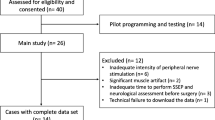At present, such a type of endoscopic surgery as robot-assisted transaxillary thyroidectomy has become available. In this case, traumatization of the brachial plexus is a rare but possible complication. For the control of the function of the brachial plexus during the above operation we used monitoring of somatosensory evoked potentials (SSEPs) induced by stimulation of the median nerve. Fifteen patients (14 women and one man) were included in this study. All interventions were robot-assisted transaxillary thyroidectomies using the daVinci SI Surgical System. We found that such surgery induced mild but significant increases in the latency of the cortical N20 potential, especially when the tissue was tensioned by the autostatic retractor. The latency prolongation was a valuable signal given to the surgeon, followed by repositioning or loosening of the retractor. In the examined group, no significant decreases in the amplitude of the N20 potential were observed. We conclude that SSEP monitoring during robotic thyroid surgery is an available and safe method providing valuable information on the functional integrity of somatosensory pathways during surgical maneuvers.
Similar content being viewed by others
References
D. Linos and W. Y. Chung, Minimally Invasive Thyroidectomy, Springer, Berlin, Heidelberg (2012).
W. Y. Chung, “The evolution of robotic thyroidectomy: from inception to neck dissection,” J. Robot. Surg., 5, 17–23 (2011).
N. Rabinovics and P. Aidan, “Robotic transaxillary thyroid surgery,” Gland Surg., 4, No. 5, 397–402 (2015).
E. H. Kandil, S. I. Noureldine, L. Yao, and D. P. Slakey, “Robotic transaxillary thyroidectomy: an examination of the first one hundred cases,” J. Am. Coll. Surg., 214, No. 4, 558-566 (2012).
M. Piccoli, B. Mullineris, D. Gozzo, et al., “Transaxillary thyroidectomy and parathyroidectomy” In Robotic Surgery: Current Application and New Trends (G. Spinolgio ed.), Updates in Surgery, Springer, Italy (2015).
C. S. Landry, E. G. Grubbs, C. L. Warneke, et al., “Robot-assisted transaxillary thyroid surgery in the United States: Is it comparable to open thyroid lobectomy?,” Ann. Surg. Oncol., 19, No. 4, 1269–1274 (2012). doi:https://doi.org/10.1245/s10434-011-2075-7.
D. D. Axente, H. Silaghi, C. A. Silaghi, et al., “Operative outcomes of robot-assisted transaxillary thyroid surgery for benign thyroid disease: early experience in 50 patients,” Langenbeck’s Arch. Surg., 398, No. 6, 887–894 (2013).
M J. Aminoff and A. A. Eisen, “AAEM minimonograph 19: Somatosensory evoked potentials,” Muscle Nerve, 21, No. 3, 277-290 (1998).
D. F. Davis, M. A. Khalek, J. Giles, et al., “Detection and prevention of impending brachial plexus injury secondary to arm positioning using ulnar nerve somatosensory evoked potentials during transaxillary approach for thyroid lobectomy,” Am. J. Electroneurodiagnostic Technol., 51, No. 4, 274-279 (2011).
A. Luginbuhl, D. M. Schwartz, A. K. Sestokas, et al., “Detection of evolving injury to the brachial plexus during transaxillary robotic thyroidectomy,” Laryngoscope, 122, No. 1, 110-115 (2012).
J. Zhang, A. E. Moore, and M. D. Stringer, “Iatrogenic upper limb nerve injuries: a systematic review,” ANZ J. Surg., 81, No. 4, 224-236 (2011).
E. Arslan, S. Unal, S. Bagis, et al., “Unilateral brachial plexus injury occurring after reduction mammaplasty,” Aesth. Plast. Surg., 26, No. 5, 372-374 (2002). doi: https://doi.org/10.1007/s00266-002-2004-z
D. Shveiky, J. N. Aseff, and C. B. Iglesia, “Brachial plexus injury after laparoscopic and robotic surgery,” J. Minim. Invasive Gynecol., 17, No. 4, 414-420 (2010).
S. W. Kang, S. C. Lee, S. H. Lee, et al., “Robotic thyroid surgery using a gasless, transaxillary approach and the da Vinci S system: the operative outcomes of 338 consecutive patients,” Surgery, 146, No. 6, 1048-1055 (2009).
J. Lee, J. H. Yun, K. H. Nam, et al., “Perioperative clinical outcomes after robotic thyroidectomy for thyroid carcinoma: a multicenter study,” Surg. Endosc., 25, No. 3, 906-912 (2011).
S. Westerén-Punnonen, H. Yppärilä-Wolters, J. Partanen, et al., “Somatosensory evoked potentials by median nerve stimulation in children during thiopental/sevoflurane anesthesia and the additive effects of ketoprofen and fentanyl,” Anesth. Analg., 107, No. 3, 799-805 (2008).
R. Nitzschke, N. Hansen-Algenstaedt, J. Regelsberger, et al., “Intraoperative electrophysiological monitoring with evoked potentials,” Anaesthesist, 61, No. 4, 320-335 (2012). doi: https://doi.org/10.1007/s00101-012-2015-3.
P. Ngamprasertwong, V. Phupong, and K. Uerpairojkit, “Brachial plexus injury related to improper positioning during general anesthesia,” J. Anesth., 18, No. 2, 132–134 (2004). doi: https://doi.org/10.1007/s00540-003-0220-6.
M. W. Coppieters , M. Van de Velde, and K. H. Stappaerts, “Positioning in anesthesiology: toward a better understanding of stretch-induced perioperative neuropathies,” Anesthesiology, 97, No. 1, 75–81 (2002).
Author information
Authors and Affiliations
Corresponding author
Rights and permissions
About this article
Cite this article
Axente, D.D., Major, Z.Z., Dudric, V.N. et al. Control of the Functionality of the Brachial Plexus during Robot-Assisted Transaxillary Thyroid Surgery. Neurophysiology 49, 295–300 (2017). https://doi.org/10.1007/s11062-017-9685-z
Received:
Published:
Issue Date:
DOI: https://doi.org/10.1007/s11062-017-9685-z




